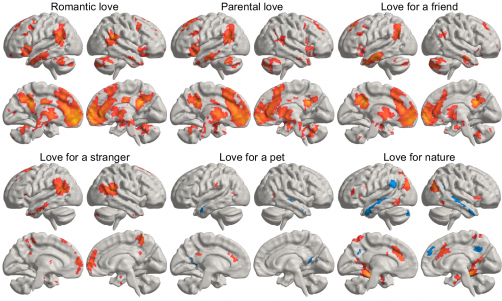
This is a map of love in your brain. Love for children activates the brain in the deepest ways. Then romantic love.
All we need now is an Elon Musk Neurolink to stimulate the desired center and we can be forever in love with our partners: a new study has mapped out various love centers in the brain, leading to new ways we can stimulate love on a path to being more productive and satisfied beings.
We all have used the word ‘love’ in a bewildering range of contexts — from sexual adoration to parental love or the love of nature.
New imaging of the brain may shed light on why we use the same word for such a diverse collection of human experiences, called love:
You see your newborn child for the first time. The baby is soft, healthy and hearty — your life’s greatest wonder. You feel love for the little one.

Love for your child is the deepest
The above statement was one of many simple scenarios presented to fifty-five parents, self-described as being in a loving relationship. Researchers from Aalto University in Finland applied functional magnetic resonance imaging (fMRI) to measure brain activity while subjects mulled brief stories related to six different types of love.
Love for children is the deepest
“We now provide a more comprehensive picture of the brain activity associated with different types of love than previous research,” says Pärttyli Rinne, the researcher who coordinated the study: “The activation pattern of love is generated in social situations in the basal ganglia, the midline of the forehead, the precuneus, and the temporoparietal junction at the sides of the back of the head.”
Love for one’s children generated the most intense brain activity, closely followed by romantic love. “In parental love, there was activation deep in the brain’s reward system in the striatum area while imagining love, and this was not seen for any other kind of love,” says Rinne.
Love for romantic partners, friends, strangers, pets, and nature were also part of the study, which was published this week in the Cerebral Cortex journal, Oxford University Press.
According to the research, brain activity is influenced not only by the closeness of the object of love but also by whether it is a human being, another species, or nature.
Unsurprisingly, compassionate love for strangers was less rewarding and caused less brain activation than love in close relationships. Meanwhile, love of nature activated the reward system and visual areas of the brain, but not the social brain areas.
Pet-owners identifiable by brain activity

The biggest surprise for the researchers was that the brain areas associated with love between people ended up being very similar, with differences lying primarily in the intensity of activation. All types of interpersonal love activated areas of the brain associated with social cognition, in contrast to love for pets or nature — with one exception.

CBD is often turned into an oil but it can be delivered in beverages and edibles for pain relief, romance
Subjects’ brain responses to a statement like the following, on average, revealed whether or not they shared their life with a furry friend:
‘You are home lolling on the couch and your pet cat pads over to you. The cat curls up next to you and purrs sleepily. You love your pet.’
Related: Making love with the 5% rule
“When looking at love for pets and the brain activity associated with it, brain areas associated with sociality statistically reveal whether or not the person is a pet owner. When it comes to the pet owners, these areas are more activated than with non-pet owners,” says Rinne.
Not only can understanding the neural mechanisms of love help guide philosophical discussions about the nature of love, consciousness, and human connection, but also, the researchers hope that their work will enhance mental health interventions in conditions like attachment disorders, depression, or relationship issues.
Comments






